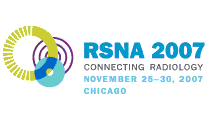
Abstract Archives of the RSNA, 2007
Regina Maria Koch MD, Presenter: Nothing to Disclose
Guang Jia PhD, Abstract Co-Author: Nothing to Disclose
Steffen Sammet MD, PhD, Abstract Co-Author: Nothing to Disclose
Gregory Anthimos Christoforidis MD, Abstract Co-Author: Nothing to Disclose
John Byron Christoforidis MD, Abstract Co-Author: Nothing to Disclose
Michael Vinzenz Knopp MD, PhD, Abstract Co-Author: Nothing to Disclose
To demonstrate the ability of dynamic contrast enhanced magnetic resonance imaging (DCE-MRI) at 3T to assess enhancement characteristics in tumors of the eye.
Ten patients with solitary orbital lesions and clinical suspicion of malignant melanoma were examined with DCE-MRI on a clinical 3T MRI system (Achieva, Philips) using an 8-channel head coil. T1 and T2 weighted images in multiple planes were acquired to select the region for the dynamic sequence. Dynamic scans were acquired using a 3D-Fast Field Echo (FFE) sequence (TR=4.2ms,TE=2.1ms,FA=15,acquisition time=11.2s, time points=42,scan time=7:50min). A Gd-chelate (Omniscan) was injected in a concentration of 0.1 mmol/kg at a rate of 0.6 ml/s after the first five repetitions of the dynamic sequence. For analysis of DCE-MRI data a pharmacokinetic two-compartment model was used. The pharmacokinetic parameters amplitude (Amp), redistribution rate constant (kep), elimination rate constant (kel) and time delay of signal enhancement (tlag) were calculated.
MRI measurements revealed a mean tumor size of (5.1+/-1.8)mm x (9.14+/-3.5)mm. Ocular lesions showed rapid initial increase in signal intensity, followed by a fast washout. Mean pharmacokinetic parameters were Amp (1.8+/-1.1)a.u., kep (45+/-29)min-1, kel (0.35+/-0.3)min-1, Tlag (1.1+/-0.18)min. Variable contrast uptake was seen within different areas of individual tumors, with the following maximum (Amp=2.2,kep=62.5,kel=0.83,tlag=1.31) and minimum (Amp=0.68,kep=0.89,kel=0.09,tlag=0.91) perfusion values.
DCE-MRI at 3T using a head coil is a valuable method for characterization of ocular lesions. Contrast enhancement patterns correlated with histopathological data if available. Higher spatial resolution and shortened scan time at 3T can improve detection and characterization of ocular lesions and could be a non-invasive substitute for biopsy that provides similar prognostic information to stratify patients risk of metastasis.
With the current trend to eye-preserving management of malignant melanoma differences in contrast enhancement patterns could help predicting the malignant potential of ocular tumors.
Koch, R,
Jia, G,
Sammet, S,
Christoforidis, G,
Christoforidis, J,
Knopp, M,
Assessment of Ocular Lesions Using Dynamic Contrast Enhanced MRI at 3T. Radiological Society of North America 2007 Scientific Assembly and Annual Meeting, November 25 - November 30, 2007 ,Chicago IL.
http://archive.rsna.org/2007/5014053.html

